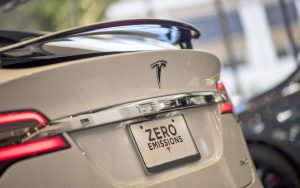EVs have a seepage problem.
They lose charge (and so, range) when they’re not in use, if they’re not plugged in while they’re not in use.
It is a problem I’ve personally experienced with half a dozen different makes/models of electric vehicle over the past six months, indicating it is a general/inherent problem rather than a “bug” that afflicts a specific make or model – and this makes sense because while there are different makes/models of EV, almost all of them have the EV equivalent of a radio that never turns off or some other small but significant accessory power draw. And it isn’t something that can be fixed – because it’s supposed to be that way.
EV battery packs have their own thermal management systems, fancy talk for a heating/cooling system, necessary to maintain the battery pack within a range of acceptable temperature, neither too hot nor too cold. This, of course, consumes electricity as everything that is powered in an EV is powered by electricity. If the EV is not plugged in, it is using battery power to power whatever is being powered – including the thermal management system – and that is why you discover you’ve lost anywhere from 5-20 miles of range (it is very temperature dependent) overnight, if you forgot to plug the car in when you got home the evening before. 
This isn’t a defect that can be fixed. It can only be compensated for.
By keeping the EV plugged in whenever it is parked.
This presents at least two issues that ought to be talked about – which the advocates of “electrification” are interestingly silent about.
Whatever critics of what are styled “IC” – that is, normal – cars may say, they do not normally (by design) waste gas when they are not in use. A supercharged V8 Hellcat may burn up a lot of gas when it is running – that is to say, doing useful work.
But when you shut off the engine and park it, none is being burned.
Or emitted – as one endlessly hears with regard to the supposed benefits of “electrifying” everything. When an IC vehicle is parked it is a zero emissions vehicle – in fact, not hype. Nothing is coming out of its tailpipe and nothing is coming out of a smokestack, either.
Unless it has a leaking gas tank, it is preserving rather than consuming energy. It is 100 percent efficient when it is not being used.
As contrasted with the efficiency losses of a parked EV. The loss of even five miles of range overnight isn’t a small thing when you haven’t got that much range to begin with and when it takes so goddamn long to get it back.
And if it’s cold out and the battery’s thermal management system is using more power to keep the battery warm it is common to wake up with 15-20 miles less range than you had the evening before – if you forgot to plug the car in. That is the rough-math equivalent of a third to half a gallon of gas up in smoke, as it were.
And it can’t be avoided.
Your choice, if you have an EV, is to either lose the charge from just sitting and replace it – by charging it – or maintain the charge being drained by keeping the car plugged in. But while you might not lose the range that latter way you, do lose the charge, either way. The EV is always losing – and so, drawing – power. It is for that reason also always emitting, too. This fact is lately being quietly admitted to in EV advertising, as this column has previously pointed out. EVs are no longer refereed to in the ad copy as “zero-emissions” vehicles but rather tailpipe emissions-free vehicles.
Because of the emissions that emanate from the sources of electricity – utility plants – that EVs continuously burn.
Some will say it’s not much – when parked – but this is of a piece with EV equivocation generally. Like the way waiting half an hour or longer for a partial charge is styled as “fast” (and the way people are not hipped to the fact that the DC high-voltage current needed t “fast” charge is not available at home).
If we were talking ’bout just one or a small handful of EVs burning-drawing power when not in use, Willis, it would indeed not be much.
But aren’t we supposed to be “saving”? And how much will it cost “the environment” when there are millions of EVs silently burning – and drawing – power, continuously, even when they are not in use?
How come no one is talkin’ about that, Willis?
Probably because it might raise questions about the wastefulness of it all.
It would be interesting to calculate the gasoline-energy equivalent of the waste, overnight, of the electricity equivalent of a third-to-half-a-gallon of gas times say five million EVs and then figure out how much in the way of “carbon emissions” this results in, for no purpose at all – as the EVs are just sitting there and not driving anyone anywhere while they waste.
And they ask me why I drink.
. . .
If you like what you’ve found here please consider supporting EPautos.
We depend on you to keep the wheels turning!
Our donate button is here.
If you prefer not to use PayPal, our mailing address is:
EPautos
721 Hummingbird Lane SE
Copper Hill, VA 24079
PS: Get an EPautos magnet or sticker or coaster in return for a $20 or more one-time donation or a $10 or more monthly recurring donation. (Please be sure to tell us you want a magnet or sticker or coaster – and also, provide an address, so we know where to mail the thing!)
My eBook about car buying (new and used) is also available for your favorite price – free! Click here. If that fails, email me at EPeters952@yahoo.com and I will send you a copy directly!













I think this is the part of the play where “they” say something like, “OK, fuck the environment already! Either you give up your fucken ICE cars and buy an EV or we get militant trannies to kill you!” (because we say so)
I mean, it makes as much sense as the tragicomedy of “social distancing”, masking or taking an experimental gene therapy for a easily survivable cold.
When they have no answer, eventually, the fangs come out and they just resort to the violence/belligerence approach because that’s what it really is anyway.
I still just can’t get over how used car dealerships were targeted in that once upon a time, now mostly forgotten, act most people associate with Kyle Rittenhouse. Those damn racist cars had to burn… for *some* reason.
I have to wonder what all that charging does to the EV battery? Especially if you were to have to keep it plugged in 24/7 to compensate for the leakage? That would mean having to buy an unaffordable battery sooner, I imagine?
Been my experience with any devices that normally operate on a battery (e.g., call phones, laptops or tablets), eventually they just stop holding charge period. Depends on the device and/or the battery but, at some point, I can leave that shit on the charger all day long. And it’ll say that it’s 100% charged but then you pull off the charger and the battery goes dead in no time flat!
And I use a lot of 1.5v AA batteries so I use rechargeables as much as possible. Well, I’m getting tired of that because those go bad all the time while others from the same batch keep working. I’ve started not bothering with rechargeables and just using the normal batteries because they cost more and it’s a pain when you need it and it’s not working.
I bet they’re gonna see a whole lot more variability to battery life once they start forcing more of these bad ideas on people.
If the MSM and every other media would run pictures of the mining in the Congo then this could be curtailed. The ones Joe Rogan had were horrific. I’m pretty sure the Gov and all the EV manufactories would throw a fit when people saw.
I still have a very small sliver of hope that people would react to seeing dead miners/children and destruction of the land.
“It would be interesting to calculate the gasoline-energy equivalent of the waste, overnight, of the electricity equivalent …” Not a whole lot of calculation involved, Eric. If they are losing 25 miles of range overnight, a very simple approximation is that a US gallon of gas or half a gallon of #2 Diesel was wasted. EVERY DAMNED night.
We just pulled the trigger on a 2023 Corolla Hybrid. We are trading in our 2015 Focus with the problematic dual-clutch PowerShift transmission.
We were on the waiting list for about four months. Today they had an all-electric bZ4X sitting in the showroom. The salesperson said it’s been there for several weeks and nobody wants it.
Gasoline & diesel vehicles also lose weight as they use fuel, something an EV will never do. Of course, the fuel for Non-EVs will only comprise about 120 to 150 lbs, or even less, for most all passenger vehicles, as opposed to the 1/2 ton of EV batteries, but facts don’t matter to bureaucrats.
‘EVs have a seepage problem.’ — eric
Since EeeVees are basically cell phones on wheels, they mirror the steady decline of a phone’s charge, even when it’s sitting idle at home.
The first couple of barely-smart phones I owned, with low-powered chips, could go as much as one to two weeks without recharging when they were not being used.
Whereas my current phone, a 2020 model, reaches critical battery after about three days of non-use. Clearly its battery is feeding substantial parasitic loads that suck power even when the screen is dark.
IC-engined vehicles can remain idle for weeks and still crank up. A couple of years ago, a friend’s Volkswagen Golf started on the first crank after not running for a year. This is impossible with an EeeVee. To remain functional long-term, it must be grid-tethered.
Parasitic loads are undesirable. EeeVee victims tolerate them, because they’ve been dependency-trained by their power-sucking cell phones to put up with this nonsense. I won’t.
I’d just as soon smash a hole in an EeeVee’s windshield with a sledgehammer, chuck in a flaming Molotov cocktail, then rip off an insurance company by claiming that some hooligans down the street lit it up. Two birds, one stone … 🙂
Amen, Jim!
And in re: “To remain functional long-term, it must be grid-tethered.”
This is very well-said and I wish I had said it. Said another way, you are tethered, by the EV. And that, of course, is just what’s wanted by those pushing them.
Can younimagine in a grid down situation having only evees. Everyone would end up with bricks in their garages.
I think we saw a taste of that in California after one of the fires a few years ago. PG&E shut the power off, and EV drivers got stranded on the roads after they lost battery charge/juice trying to get away. Whoops. Guess they are not worth much in an emergency scenario.
One feature of my drone “smart batteries” is a long-term storage mode. This will discharge the battery after a 7 day or programmable timer elapses to about 50% charge. This will maximize battery longevity. I normally charge batteries the night before I fly so I’m not caught stranded with half the expected flight time.
Taking a look at this page https://tinyurl.com/55866f54 (www autovolt-magazine.com / how-to-park-your-ev-for-long-periods-manufacturer-guidance). Manufactuers are all over the map when it comes to recommendations for long term storage. Most of them recommmend keeping the vehicle plugged in for the duration and letting the BMS do whatever it needs to do, although there are a few notible exceptions:
Jaguar
I-Pace – In the event of long-term storage, make sure to charge the high voltage battery every 30 days.
CAUTION: Make sure that the high voltage battery is charged to a target of 30% and no more than 60%. Failure to do so may result in damage to the battery. I wonder if that will void the warranty?
Mitsubishi
Outlander PHEV – Mitsubishi does not recommend leaving your car plugged in for a longer period of time than necessary.
While you’re not driving it, aim to keep the charge at around the 30% mark and leave it unplugged. You can then charge the car up to full just before you need to use it.
Nissan
For the high-voltage battery it is recommended that the state of charge is kept between 50% and 80%, and not to leave the vehicle plugged in once the high voltage battery has finished charging.
Do not operate the charging timer repeatedly while the charge connector is connected to the vehicle after the Li-ion battery charging is completed. Doing so may discharge the 12V battery.
Avoid exposing a vehicle to extreme ambient temperatures for extended periods to maximuse battery life. Owners should avoid storing a vehicle in temperatures below 23ºC for more than seven days.
Avoid leaving your vehicle for more than 14 days where the Li-ion battery available charge gauge reaches a zero or near zero (state of charge).
Park/store your vehicle in cool locations out of direct sunlight and away from heat sources.
Imagine parking these things at the airport for a month in the long term lot. When you get back you’ll have to spend an extra two hours recharging, or your battery might be completely dead, or you find out that because you let it sit in a manor that wasn’t by the book you no longer have a warranty claim (because everything is logged in the BMS). If you have a dead SLA battery someone can give you a jump start. I supose if you had a leaky fuel tank you might not have any gas, but adding a jerry can’s worth will at least get you out of the parking lot and to a gas station. And there’s exactly 0% chance the airport won’t gouge you at the nearby convenient charging station.
I’ve been reading lately about Biden Thing’s upcoming ban on incandescent lightbulbs beginning in August. Also more stupid rules for appliances and air conditioners. Soon, all of these devices that used to work, won’t. As much as I dislike Orange Man, at least he did provide a pause in the progression of that nonsense.
Amen, Roland –
It calls to mind that scene in Braveheart. Young Wallace is with his uncle, mourning the death of Wallace’s father. The men are playing “outlawed tunes on outlawed pipes.” And so it is, again.
I think the worst part is hearing the insufferable Jennifer Granholm blabber about how this is going to be sooooo good for you because of all the money it will save. As if devices that cost less while doing a better job won’t sell unless the old ones are banned.
Literally a page from Keynes. Destroy a productive asset in order to build a new one. Think of how much “wealth” will be added to the GDP! The tax revenue! Burn it all down so that firefighters will have something to do.
All of the replacements have advantages and disadvantages. I have several RGB LED light strips in my home. They make great accent lights. But for reading, LED lights are terrible. And for lights that only get occational use, like outdoor patio lights, it just isn’t worth paying up front for LEDs when incandencents are so cheap and for the amount of use they get don’t have much of a “carbon footprint” anyway.
The “efficient” heat pump runs on electricity, which costs much more than natural gas, basically negating any savings over fossil fuels. But add in the up-front cost of abandoning my hot water baseboard and retrofitting the house for mini splits and the balance slams down in favor of keeping the gas boiler. I estimated the difference would take decades to even out, if I paid cash. I don’t even want to think about if I had to take out a loan. And the boiler is something I can maintain myself. Vaccum out the combustion chamber once in a while. If the control module (can’t get a thermopile/pilot anymore) fails, it’s a very easy swap. And if I have an extended power failure I can run it off a small generator easily. In the case of a true SHTF event, it can be converted to propane, and probably wood gas too.
We have a lot of LEDs, and for the most part they are OK. I’m more concerned about appliances. The washer we have usually puts a ridiculously tiny amount of water in no matter what the settings, but I can run more in with a hose from the laundry sink next to it. I suspect that if we have to replace it, the new one might have sensors that won’t let me do that. Or it will rat me out and the energy cops will haul me away, stinky clothes and all.
Roland said “if we have to replace it”
The first issue is why you would need to replace it. Was it due to wear and tear, failed unit that repair exceeds value (almost never the case), new feature you cannot live without, or government mandate? Most people don’t give their appliances any thought whatsoever until they break down. When it comes time to buy a new washing machine I doubt anyone pays any attention to the Energy Star rating. They need a new machine, delivered before wash day and at an out of pocket price that won’t force them to eat beans for two months.
I house sat for some friends, who had the “water saver” (front loading) washer. It took a good, hour and a half to “wash” my clothes, compared to my old, non-chipped washer that actually fills up to the brim with water, and then vigorously agitates the clothes in a fraction of the time. As opposed to taking them out for a Sunday stroll that my friends washer seemed to do. I cannot imagine the new washers having even less water. You might just as well use the old fashioned metal buckets and wash boards, and do it yourself, as you would get better results in a fraction of the time.
This will conveniently set up the next grift opportunity in 10 years. It will finally be publicized in the mainstream media as a great threat to “our” infrastructure and “climate change.” After 24 months of teeth gnashing and use as a political tool, it will be “fixed” with a new infrastructure bill that will give $900 billion to politically connected contractors to increase the output of “our failing electrical grid.” Problem solved until the next manufactured crisis, and we will be all the poorer.
PROBLEM, REACTION, SOLUTION. Rinse and repeat.
But, Eric, Brie Larson … Captain Marvel …
One thing that should have had the EV believers scratching their heads is when our would be overlords specifically asked to be driven around in gas powered vehicles instead of EVs at their yearly meeting in Davos back in January.
Right John,
How much more obvious can it get that our overlords make rules for thee, but not for me.
Mike,
We also saw that when states had mask mandates and draconian lockdowns in place at the height of COVID hysteria, and numerous politicians skirted their own rules. But I’m not aware of any COVID rule enforcers or snitches ratting out elected officials, but they sure went after ordinary people who dissented.
“Request denied!”
I suppose you are in denial when the EV you have always uses electricity and you aren’t supposed to notice.
Always a squirrel to distract your attention.
Dot gov must be in self-denial if it chooses to ignore a problem with EV’s.
Make the ICE go away. All that counts.
“Some will say it’s not much – when parked”
Then they will say it IS much, when considering emissions from ICVs. That the very slightest increase or decrease in CO2 emissions is catastrophically critical to save “the climate”. The EV is not a solution for anything, except to control and limit private personal travel. A thousand pounds heavier. which uses MORE energy, and results in more wear and tear on tires, and brakes, and roads. Has half the service life of an ICV, which means a new one must be built twice as often. The environmental and human catastrophe inflicted to supply Lithium and Cobalt, which really are in very limited supply, unlike Hydrocarbons. In sum, they don’t accomplish any of the proposed goals of using them. Of course controlling and limiting private personal transportation is NOT one of those “proposed” goals, but that’s the precise and only goal of using them. Because otherwise, they are a total failure.
There are people who complain about “phantom loads.” This was a bigger deal in the 1990s when linear power supplies were more common. Some of the worst offenders were cable boxes because Motorola kept the same internal design for decades and never bothered to improve them, and they were always on so that the company could poll them for PPV purchases and shut them down when the bill got past due. Unplugging them meant the TV guide data had to re-download, which could take hours.
I still have a 12VDC, 50A linear power supply for my radios. It will get hot to the touch if I’m running full power or a high duty cycle mode during a contest. But it is completely RF silent compared to a switcher. All that heat is inefficiency, although switchers have a terrible power factor, so they waste electricity too.
People are starting to notice this – but what I find interesting is how many just dont care – but like you’ve said imagine if it was a petrol car leaking fuel (and money) as it sat there ! Imagine the noise from regulators. Or if this wasn’t “declared” before hand, imagine the field day lawyers would have…. where are those lawyers now !!
Good point, Nasir. People probably they don’t care because we’re accustomed to appliances drawing power 24/7/365. The microwave & oven draw continuous power for the clock. The ‘smart’ tv always draws power even in “low power mode” bc of the obnoxious red light. How many other things in our own homes do we see powered up all day?
Just to be absolutely certain that your observation is correct, you should also check the battery’s remaining percentage charge for instance after 24 hours (remaining kWh). This in order to rule out the possibility that the car was parked on a mild afternoon, and that it was restarted on a noticeably colder morning.
I’m sure, Jone –
I’ve experienced this same issue with half a dozen different EVs, different makes/models…
No such problem exists for ICVs, regardless stopping and starting temperature. An accurate evaluation of the “efficiency” of EVs SHOULD include extreme conditions. Since ICVs don’t have any such problems until you get to sub-zero temperatures. Diesels do need an electrical heater at those temperatures to start, but EVs nearly AWAYS need them, or an electrical cooler, unless temperatures are in a very narrow “Goldie locks” zone.